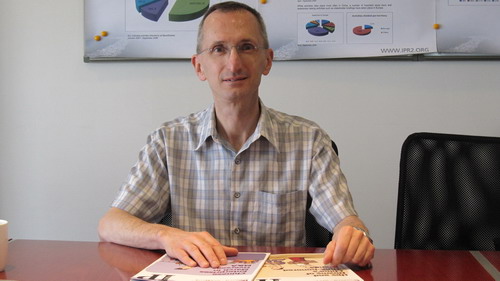 |
|
Pandolfi Carlo, IPR2 Technical Assistance Team Leader
|
An Interview with Pandolfi Carlo, IPR2 Technical Assistance Team Leader
IPR2 is the second partnership project between the European Union and the People’s Republic of China on the protection of intellectual property rights in China. The Ministry of Commerce is the Chinese IP implementing organization. The European Patent Office is the European IP implementing organization. With more than EUR 16 million in joint funding over 4 years to 2011, IPR2 aims to strengthen the enforcement of IPR by targeting the reliability, efficiency and accessibility of the Chinese IP protection system through holding different activities such as workshops, meetings, training programs, information management as well as close cooperation with Chinese small and medium-sized enterprises.
When talking about EU-China IPR activities, IPR2 is the first word that comes to mind for insiders. And if you are talking about IPR2, you simply must mention Pandolfi Carlo; a technical assistance team leader and highly regarded figure in the IPR2 community.
Mr. Pandolfi was born in Turin, Italy in 1959. When asked about his memories and impressions of his hometown, he cheerfully describes the city as full of a gothic atmosphere with artful treasures and unique constructions. Turin is no bigger than most Chinese cities or towns; with a population of more or less 1 million. However, the small city has endowed him with the special understanding about humanity and nature. In his viewpoint, art, food and climate constitute the common elements of all historical yet highly industrialized cities. He consistently plays the role of a communication bridge between different areas and regions. No matter how trivial the matter, he will plunge into the work enthusiastically. When asked about his impression of China and China’s IP development, he said it couldn’t be expressed in a few words.
Mr. Pandolfi joined the IPR2 project in 2008 as the team leader. Before joining IPR2, he committed himself to IPR communication and traveled among EU member countries. With a doctor’s degree in physics and rich IP knowledge on patents, he has been involved in international cooperation activities for the European Patent Office for about 15 years. Initially in charge of the formulation and follow-up of cooperation activities between contracting states and the EPO, he also coordinated the political debate and the revision of the cooperation programmes.
Later, setting up and launching an EPO liaison Bureau in Brussels became a reality. At the same time, Carlo managed IT and IP projects with the Trilateral Partners, namely, the EPO, the Japanese Patent Office and the United States Patent Office. His coming to China will add a totally new page to his communication book.
The first interview invitation from China IP was on the media workshop of IPR2. The second one came after the press release of the, “new legal platform for intellectual property in the EU.” This is the third time we have had the honor to interview Mr. Pandolfi! With questions and expectations, we entered his office in Beijing for a discussing of his life experience, the operational status of IPR2 as well as some hot IP topics.
China IP: You received a doctorate degree in physics. Why did you choose intellectual property as your career?
Mr. Pandolfi: When I was studying, it was a long time ago. IP was not a primary major at the university, and was only offered as a secondary one. So I started with technique background working for the industry. Later I realized the importance of IP enforcement in the EU in my career, and about twenty years ago I decided to move into patent protection. That’s how I got into patent protection and that’s why I moved from technique background to a more legal focus. It is a quite common process in Europe, to complete the technique background with intellectual property by going into patent protection. The fact is that if you talk about patent protection, it is mainly a technique issue which needs to be described legally. Therefore, there is a need to somehow combine technical knowledge with IP knowledge.

